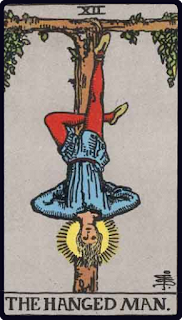
Where Justice focused on the justification of our actions, the Hanged Man embodies the consequence of our actions. Representing consequence, revelation, closure, stagnation, and reflection, the Hanged Man serves as a stopping point, a cessation of movement if only for a short period of time.
In the upright position the Hanged Man asks us to stop and reflect upon our current position and consider the path that led us to this point, and what actions or inactions we have taken that brought us here. It is easy to blame our circumstances on others and our environment but human beings are remarkably adaptable as evidence by our continued existence despite the many threats that are posed to us as a collective. Our ingenuity shines brightest when we are faced with insurmountable problems and must seek solutions that at times may seem unorthodox or counter intuitive.
In the inverted state this point of reflection is maintained but its focus shifts outward to our environment, and the impact we have had upon it and to consider whether the adverse impacts upon us that we attribute to our environment have been amplified or mitigated by our own actions. We may be in a precarious position but whether or not we deserve to be there, our actions and our response can make that situation better or worse depending on how we compose ourselves, reacting to anger directed at us with anger in turn, will only amplify and escalate that situation, regardless of whether we consider that escalation justified, we must take ownership of that consequence.
In the Rider-Waite deck, despite its name conjuring up images of the gallows and capital punishment, the individual depicted is not a criminal sentenced to death but rather a performer. The Hanged Man is sometimes interpreted as a magician, or an illusionist, or an acrobat who hangs suspended from a beam upon which they had been balanced, secured by a safety rope it is this rope from which the hanged man swings.
Hanging in their precarious state the individual is illuminated by a halo representing the reflection and subsequent revelation achieved whilst enduring this moment of stagnation. In the bottom right once more the Rod of Aaron is present representing the omnipresence of God and the threshold of revelation that can be reached when we stop and reflect upon our lives.
Whilst often seen as an omen when read by the uninitiated, the Hanged Man represents the consequence of action, the effect that follows a cause. Even when read in a spiritual sense this card is not intended to portend malice, it can be useful to let it serve as a prompt to consider the consequences or the return on an investment.
Where Strength emphasised the awareness of the cost to each domain that our commitments have on us, the Hanged Man instead prompts us to consider what we are experiencing in the moment and consider it the consequence of a past action, or to look forward and consider what the potential consequences of our actions may be.
When something good or bad happens to us this card can be useful as a prompt to consider what we did to cause or prevent the situation. This card emphasises recognition of the rewards of hard work and investment, and recognition of a lack of preparation or caution respectively.
In self-reflection the most useful question in this context is to ask “How did I get here?” or “Could I have prevented this?” and in recognition of a return on investment “How much work did I put into this?”

No comments:
Post a Comment
All comments are moderated before they are published. If you want your comment to remain private please state that clearly.